This post contains affiliate links. We may get paid an affiliate commission if you buy something or take an action after clicking one of the links on this web page.
Last Updated: August 5, 2019
Few of us have the money to shell out hundreds of dollars for every knife we think we might like. We have to cull the herd. Maybe we splash out for a promising ‘Maybe’ every once in a while, but 80% of the time we go for the sure thing. Most of the knives I skip I forget about, with nary a second thought given them. But every so often a Maybe knife won’t be forgotten. It lingers in the memory and asks me over and over again, “What if you’re missing out on something special?”

Buy Freeman Outdoor Gear at BladeHQ
Such was the case with the Freeman Outdoor Gear 451 Flipper. I heard good things, and admired the flipping action, unique aesthetic, and button lock mechanism from afar. My cursor would hover over the “Add to Cart” button on the Freeman website, but I never could quite commit. Thankfully, a friend and fellow gear geek offered to send his 451 my way to try out.
After wondering for years what this knife is like, I’ve had a chance to try it out, and the news is mostly very good. The Freeman 451 flipper manages to bring a unique set of features to a section of the market that is saturated with a lot of sameness. It goes deeper than a straightforward recommendation, but there’s a lot of interesting things to cover.
General Dimensions and Blade Details
The 451 has a blade length of 3 5/8”, a handle length of 5 1/8”, an overall length of 8 13/16”, and is made in the USA. There are bigger blades than the 451, but this pushes up right against the limit of what I would consider reasonable proportions for something that folds and is meant to be carried the pocket. That is strictly a function of the 451’s overall shape, however: at 5.5 oz. it’s actually quite light for its size.
The market is so rife with drop points that you think I’d be sick of looking at them. However, the proportions and grind make the 451’s blade shape memorable and useful. This feels like a blade that can take a beating , with thick blade stock and a lot of material brought right up behind the edge, but the grind is masterful: a mirror-polished secondary bevel that is nice and wide without being thin or brittle. The result is a combination of toughness and slicing ability that is rare in big blades. This is probably as good a balance as you’re likely to see on a knife this size.
The striations on the blade are bound to polarizing. I actually think they’re look pretty good, and they make cutting through choky material like cardboard easier. The knife almost ‘revs up:’ the longer the pull through material, the easier it gets. They might cause issues with long-term sharpening, but other than that I can’t complain.
Steel here is D2. This is a venerable tool steel that I have had very little experience with before now. The edge was very clean and very sharp. I think the thick stock and wide-but-not-narrow edge bevel really accentuate D2’s edge holding ability while minimizing its reported tendency to chip. In another smart move Jeff Freeman chose to Cerakote the blade. As a semi-stainless tool steel, rust is a concern with D2. In an uncoated blade the grooves would give me pause; I can see moisture creeping into them and wreaking havoc. Thankfully, between the coating and the mirror polish on the bare edge, I’d say you’re pretty much protected set barring grossly neglectful behavior.
Handle, Ergonomics, and Carry
The handle on the 451 looks like your average one finger groove affair, but that isn’t quite how it feels when you’re holding it. That finger groove is huge. It can accommodate two fingers, actually, but it works best with one finger in it. Holding the knife naturally, the pointer finger rests at the very bottom of the groove. This gives your knuckle some clearance so it isn’t butting up against the flipper tab – something that so many flipper knives neglect to do.
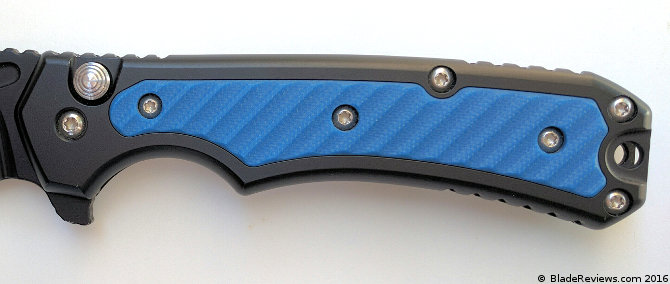
In terms of control, it’s good. Your hand is situated pretty far back. You undoubtedly lose fine control, but fine cutting tasks aren’t the 451’s calling. I used to think that all big knives that couldn’t also do fine cutting were needlessly sacrificing something, but that’s not true. Just because the PM2 can function as an EDC doesn’t mean that all larger knives have to, and really the PM2 is just barely a big a knife anyway. The 451 is much more clearly meant for specific kinds of tasks, and in those tasks the ergonomics are great. There’s a sort of finger choil on the blade itself as well, but I found it a little too close to the edge for my comfort.
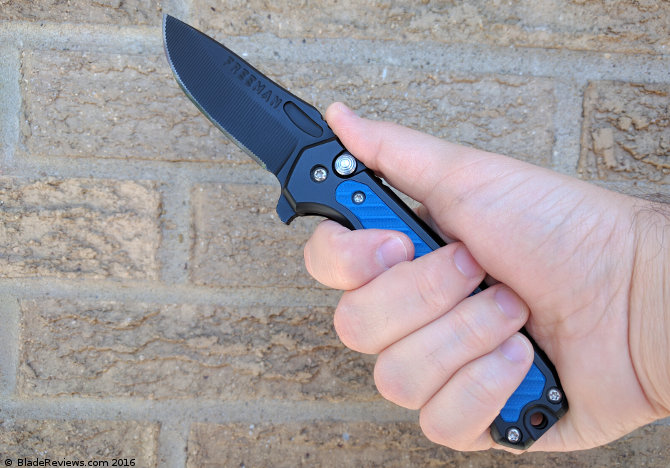
The 451 carries quite well for a big knife. You could EDC it if you wanted and not be totally displeased with the in-pocket feel. But where I think the 451 excels is in its lightness and narrow frame relative to other hard-use big blades. You aren’t going to feel like you have a paperback strapped to your thigh carrying the 451 on a hike. The aluminum frame is gentle on your pockets and the titanium clip is adequately-tensioned and beefy as hell.
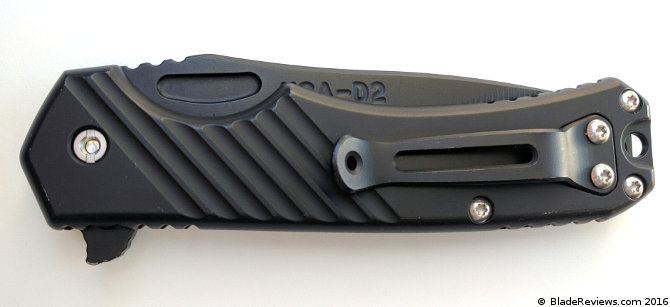
Deployment and Lockup
I don’t think flippers are, in any way, an improvement over thumb studs or opening holes. I tend to think that they are in fact actively worse. They often muck up the ergonomics of a knife, and they always make it a worse carry. The 451 makes its flipper as agreeable as possible.
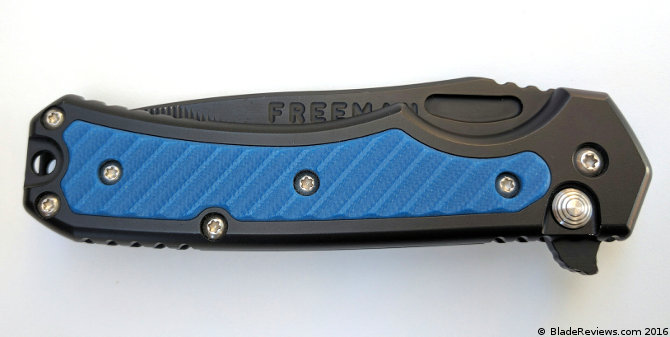
It deploys surely and swiftly every time. The weight of the blade and the strength of the detent make the 451 a snappy and sure flipper. You have to try to mess up the flipping in order to get the 451 to not lock up. It’s hard to do.
The button lock is still something of a novelty in the knife world, isn’t it? Hogue has been using it with success, but other than that the only non-automatic production maker using button locks regularly is Gerber. Maybe this is a vestige of Freeman’s influence on the company (he was head designer there for many years), who knows.
Either way, the Freeman clearly believes in the button lock, and it’s easy to see why. On the 451 it is strong, secure, and easy to engage/disengage. Your fingers don’t have to be in the blade channel to disengage it – a major positive given the free-swinging blade. There is variability in the amount of play I get when I lock the 451 up, but it’s never enough play that I care. The button lock also sticks to greater or lesser degrees depending on how hard you flick it. I think these are characteristics of the lock design, and not indicative of poor fit and finish or tolerancing.
In many ways this button lock reminds me of the Axis Lock. It’s probably slightly worse than the Axis, if only because it isn’t ambidextrous, but I never doubted its strength or security, and I am happy to see something in this price range without a frame lock.
Freeman 451 Flipper Review – Final Thoughts
I’m glad I got to try out the 451 flipper. It answers a question I’ve been asking for a long time: Is it a good knife? The answer is a definite yes. Would I buy one for myself? That’s a tougher call. When the 451 first came out, it was a little cheaper ($200 instead of $225), and the market was way less competitive. If you’re looking for a big high-end knife there are a lot of choices out there at or under the same cost, some with better features like S35VN steel – which you can get on the 451, but for a significant premium that puts the knife well outside of reasonable.
If I had bought and reviewed the 451 when I first learned about it, it would have my unreserved recommendation. What a difference a couple years and $25 can make! The 451 is still a competitive knife in a lot of respects. The materials are simple but very well-executed. It’s nice and light for its size without sacrificing any sort of durability. And personally, I think it’s a really cool-looking knife. I can’t say that the 451 is a must-buy, but definitely don’t ignore this knife when you’re looking for something big and bold.
I recommend purchasing the Freeman Outdoor Gear 451 Flipper at Amazon, KnifeArt, BladeHQ, or you can buy it direct from Freeman Outdoor Gear. Thanks for checking out the review.
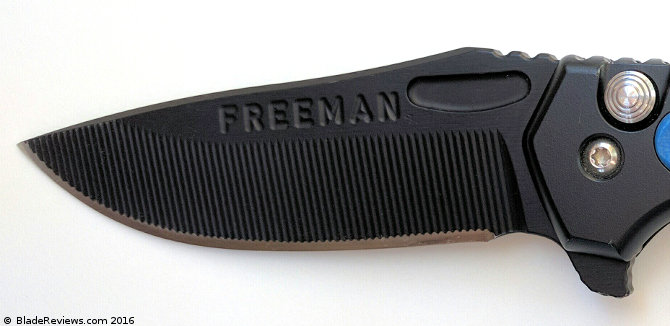
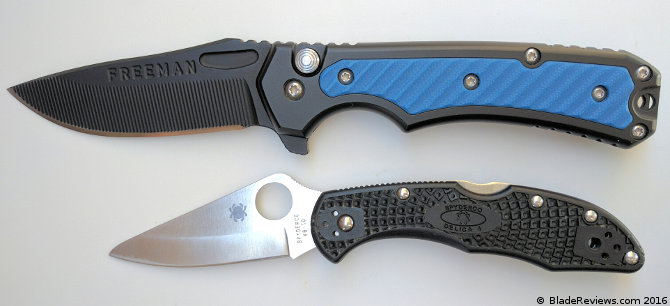
Great review, Ben! You mentioned that the striated grind revs up in cutting cardboard. Was this just a reference to the noise generated, or does it actually help in cutting?
Hey Grayson,
Thanks for the comment! Yes, the revving up actually helps in cutting, and is more a feeling than an actual sound – although that would be incredible if it were audible as well, haha.
Ben.
WOW! That is one sweet knife…m u s t h a v e. How have I never heard of these before?
Hey Rob,
Yup, it’s a looker alright! And believe me, it’s even better in person. Despite a lot of the usual inclusions -flipper, black coating, etc. – it manages to look like nothing else out there. You can get the G-10 insert in a variety of colors too.
Ben.
Totally agree with you on flippers. They are fun, but for some tasks, especially carving, all they do is put more distance between your hand and the edge.
Hey Brad,
Definitely. That’s probably my biggest problem with flippers: they make a knife more fun to play with, but harder to use. At best, your hand is still further away from the blade than it needs to be.
Ben.